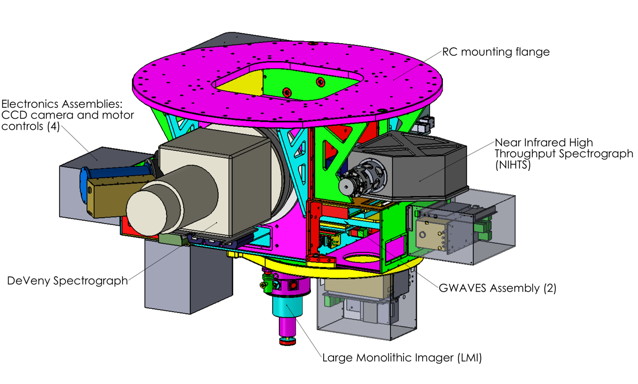
LMI: Hardware

The instrument sits at the straight-through position of the Ritchey Chretien
focus, at f/6.2.
Following the light path:
- Retractable Atmospheric Dispersion Corrector (ADC), not shown. The
design study has been funded, but implementation will not be for several years
after first light.
We expect that on nights of good
seeing that atmospheric dispersion will dominate the image quality
through broad-band filters---at an airmass of 1.3 differential refraction
within the B band will smear an otherwise 0.7" image out to 1.2".
The ADC needs to be retractable as it cannot be made with good UV tranmission,
and so needs to be removable from the beam for good U-band photometry.
- RC two-element corrector uses fused silica lenses. This corrector
flattens the field and removes the astigmatism that is characteristic of
Ritchey-Chretien designs, and is designed to minimize ghosting.
- Image quality: The spot diagrams show FWHMs of 0.085 arcsecond at V at 0.25 degree from
field center, about twice as far as the corner of the LMI FOV.
- Astrometry: The resulting field is nearly distortion free,
with the image scale smoothly changing from 7.99601"/mm at field center to
7.99804"/mm at 8.7' from field center, corresponding to the very corner
of the LMI FOV, a change of less than 0.03%, and in the sense
of classical pincushion distortion. Using the "standard
model"that f=r(1+c r^2), where f is the radial distance in the absence
of any distortion and r is the radial distance in the focal plane from the
tangent point, the corrector constant c is about 175, very similar to that
of the AAT triplet, and somewhat larger than that of the WIYN Hydra
port (77). Another way to put this is that by adopting the best average plate
scale, astrometry would be off by a maximum error of <0.5" if one ignored
the pinchusion term.
- Stellar photometry: The PSF should be quite constant:
At the corners of the LMI field a 0.5" FWHM will have 4.169 pixels FWHM,
while in the corner of the field, it would have 4.176 pixels FWHM.
- Surface photometry: Great care was spent investigating and minimizing
ghosting in the corrector design. The ghost pupil from the night sky
should produce uniform illumination on the CCD except at the very edge,
and a 12th mag star would be necessary to produce a coherent ghost pupil
of 30 mag/arcsec^2.
- Dual 10-slot filter wheels provide capabilities of having
18 large (4.75-inch x 4.75-inch) filters mounted at any one time.
The filters are in the converging f/6.2 beam, and thus even
narrow bandpass interference
filters can be used, as all parts of the field will see the same wavelengths.
- Bonn 125-mm shutter. These shutters have a reputation for being utterly
reliable, and can be used into the ms regime for 1% photometry. They are
sliding blades, so all parts of the field will be uniformally illuminated
at any exposure time.
- CCD Dewar
- Quartz window. The window is flat; attempts to design this with
optical power (i.e., as part of the RC corrector) resulted in unacceptable ghosting.
- e2v CCD 231 6Kx6K chip: 6144 pixels in serial register dimension and 6160 along columns. The pixels are 15µm in size, resulting in the detector
covering 92.16 mm x 92.40 mm.
- This chip has the same wiring, clocking, and amplifiers as the 4Kx4K version in NASA42 Cam.
- Test sheet for this device can be found here.
- Cooling is done
by a Stirling Cycle cooler with vibration dampening.
The chip is held at a temperature of -120C; dark current is neglible.
- Leach Generation III controller. We standardized on ARC (Leach) CCD controllers many years ago, and so are intimately
familiar with their hardware and DSP code. The same controllers will be used
for other DCT instrumentation, simplifiying the issue of spares.
Other Hardware:
- Flat fielding can be best achieved by observations of twilight flats; we also provide a flat field spot attached to the dome.
- An all-sky camera will provide real-time monitoring of sky conditions,
and these images will (eventually) be archived in a way that they are readily accessible
after the fact.
These results made use of the Discovery Channel Telescope at Lowell Observatory. Lowell is a private, non-profit institution dedicated to astrophysical research and public appreciation of astronomy and operates the DCT in partnership with Boston University, Northern Arizona University, the University of Maryland and the University of Toledo. Partial support of the DCT was provided by Discovery Communications. LMI was funded by the National Science Foundation via grant AST-1005313.


